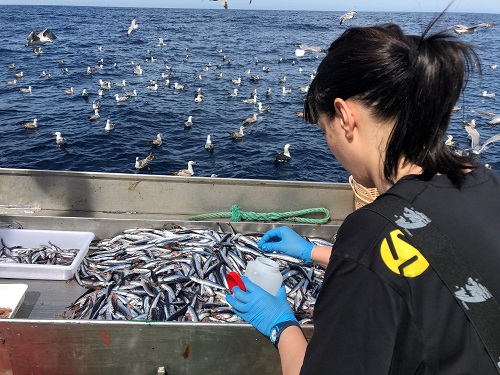The AZTI technology centre and the Basque Government have presented the provisional results of the Bioman scientific campaign

The AZTI technology centre and the Basque Government present the provisional results of the Bioman scientific campaign, which this year estimates an adult anchovy biomass of around 230,000 tonnes
The definitive data on the abundance of the anchovy stock in the Bay of Biscay will be obtained at the end of 2022 from a joint analysis also prepared with data from the Pelgas (Ifremer) and Juvena (AZTI) campaigns, which will be used to provide advice in the determination of the TAC (Total Allowable Catch) for 2023
The Bioman campaign is funded by the Department of Economic Development, Environment and Sustainability of the Basque Government and the European Commission, and has the collaboration of the General Secretariat of Fisheries of the Ministry of Agriculture, Fisheries and Food
 The annual Bioman scientific campaign, led by the AZTI technology centre, estimates a provisional biomass of adult anchovy of around 230,000 tonnes for 2022, a figure well above the minimum value that guarantees the sustainability of the species (21,000 tonnes).
The annual Bioman scientific campaign, led by the AZTI technology centre, estimates a provisional biomass of adult anchovy of around 230,000 tonnes for 2022, a figure well above the minimum value that guarantees the sustainability of the species (21,000 tonnes).
The Basque Government’s Deputy Minister of Agriculture, Fisheries and Food Policy, Bittor Oroz, the Director General of AZTI, Rogelio Pozo, accompanied by representatives of the sector, today presented the data from the campaign for this species which, during the 2022 coastal season, has recorded catches by Basque vessels of 6,528 tonnes with an average price in the fish market of 1.58 €/kg.
“The results confirm the good state of the stock of the species in the Bay of Biscay. This is excellent news that highlights the commitment we have made for years to environmental sustainability and to the Basque fishing sector for a resource that employs more than 3,500 people in the Basque Country”, stressed Oroz, Deputy Minister of Agriculture, Fisheries and Food Policy.
The Director General of AZTI, Rogelio Pozo, also highlighted the positive trend in the results of these campaigns in recent years and was optimistic about next year’s coastal season. “Of the total number of individuals in the population, 55% of the specimens are of age 1, an average high figure that is above the average of the historical series and which seems to predict that the 2023 coastal season may also have positive results,” he said.
The campaign was carried out during the month of May on board the oceanographic vessels Emma Bardán and Vizconde de Eza of the General Secretariat of Fisheries of the Ministry of Agriculture, Fisheries and Food, and subsequent analysis of samples in the AZTI laboratories.
At the end of the year, the final estimate of anchovy biomass will be obtained from the joint analysis of the data collected not only from Bioman 2022, but also from the Pelgas 2022 and Juvena 2022 campaigns and the coastal catches.
Impact of climate change
Moreover, since 2016, Bioman not only analyses anchovy biomass but also has an ecosystemic approach.
It is an integral commitment to the sustainability of the seas that evaluates not only the biomass of fish, but also their diet (study of zooplankton and ichthyoplankton); or their habitat, in terms of predators (including cetaceans and birds), oceanographic variables (essential physical properties of seawater such as temperature, salinity, etc.).
“Over the last 35 years we have observed an upward trend in anchovy food. Zooplankton, and more specifically copepods – which are the small crustaceans that make up almost 70% of zooplankton – have increased by 2.4% per decade, which is good news since, without food, there is no fish,” say the technology centre.
The Bioman scientific campaign is funded by the Basque Government’s Department of Economic Development, Sustainability and Environment and the European Commission. It also has the collaboration of the General Secretariat for Fisheries of the Ministry of Agriculture, Fisheries and Food.




